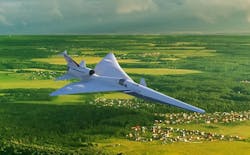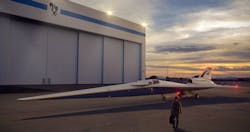Lockheed Martin building NASA X-plane Low-Boom Flight Demonstrator to usher in supersonic commercial air travel
WASHINGTON. NASA is taking another step toward re-introducing supersonic flight with a $247.5 million contract to Lockheed Martin Skunk Works, part of Lockheed Martin Aeronautics Company (NYSE:LMT) in Palmdale, California, for the design, manufacture, and flight testing of a supersonic aircraft that reduces a sonic boom to a gentle thump, officials say.
Under the Low-Boom Flight Demonstrator (LBFD) cost-plus-incentive-fee contract, Lockheed Martin will complete the design and fabrication of the X-plane experimental aircraft designed to make supersonic passenger air travel a reality. X-plane will cruise at 55,000 feet at a speed of 940 mph and create a sound as loud as a car door closing, 75 Perceived Level decibel (PLdB), instead of a sonic boom. Work under the contract began 2 April 2018 and runs through 31 Dec. 2021.
NASA awards a contract for the design, building, and testing of a supersonic aircraft to Lockheed Martin Aeronautics Company of Palmdale, California. (Credit: NASA)
Upon accepting the aircraft from the contractor in late 2021, NASA will perform additional flight tests to prove the quiet supersonic technology works as designed, aircraft performance is robust, and it’s safe to operate in the National Airspace System (NAS).
Beginning in mid-2022, NASA will fly the X-plane over select U.S. cities and collect data about community responses to the flights. This data set will be provided to U.S. and international regulators for their use in considering new sound-based rules regarding supersonic flight over land, which could enable new commercial cargo and passenger markets in faster-than-sound air travel.
"It is super exciting to be back designing and flying X-planes at this scale," says Jaiwon Shin, NASA's associate administrator for aeronautics. "Our long tradition of solving the technical barriers of supersonic flight to benefit everyone continues."
Lockheed Martin Skunk Works is building the aircraft based on its preliminary design developed under NASA's Quiet Supersonic Technology (QueSST) effort. The X-plane will help NASA establish an acceptable commercial supersonic noise standard to overturn current regulations banning commercial supersonic travel over land.
NASA's aeronautical innovators are leading a government-industry team to collect data that could make supersonic flight over land possible, dramatically reducing travel time in the United States or anywhere in the world.
The Low-boom Flight Demonstration mission has two goals:
1) design and build a piloted, large-scale supersonic X-plane with technology that reduces the loudness of a sonic boom to that of a gentle thump; and
2) fly the X-plane over select U.S. communities to gather data on human responses to the low-boom flights and deliver that data set to U.S. and international regulators.
Using this data, new sound-based rules regarding supersonic flight over land can be written and adopted, which would open the doors to new commercial cargo and passenger markets to provide faster-than-sound air travel.
Elements of NASA's Low-boom mission are organized within two of the agency's aeronautics programs -- the Advanced Air Vehicles Program and the Integrated Aviation Systems Program -- and managed by a systems project office whose members span both programs and all four of NASA's aeronautical research field centers: Langley Research Center in Virginia; Glenn Research Center in Cleveland; and Ames Research Center and Armstrong Flight Research Center, which are both located in California.
Lockheed Martin Skunk Works and NASA have partnered for more than a decade to enable the next generation of commercial supersonic aircraft. NASA awarded Lockheed Martin Skunk Works a contract in February 2016 for the preliminary design of the supersonic X-plane flight demonstrator. The aircraft will be built at the Lockheed Martin Skunk Works facility in Palmdale, California, and will conduct its first flight in 2021.
Headquartered in Bethesda, Maryland, Lockheed Martin is a global security and aerospace company that employs approximately 100,000 people worldwide and is principally engaged in the research, design, development, manufacture, integration and sustainment of advanced technology systems, products and services.



